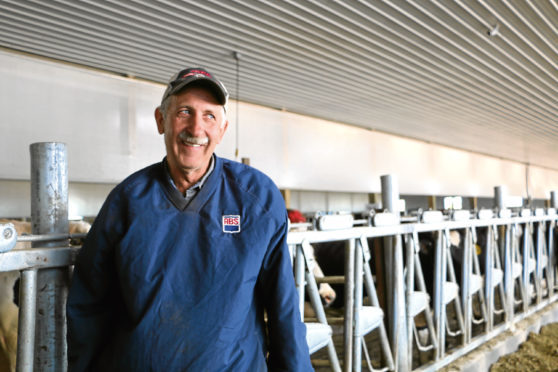Installing a robotic dairy has helped one Minnesota family overcome their staffing problems while giving an unexpected boost to cow health and productivity.
Brothers Mike and Dean Youngren, of Youngren Dairy, Pennock, were keen to expand their 300-head herd when Dean’s son, Travers, decided to come back to the farm.
With limited space in their existing sheds the family wanted to build a new barn and parlour. However a shortage of local staff meant they knew they would need a new approach to make the business work.
“We’ve always been understaffed,” said Mike. “This is a big dairy region in the United States, but local people don’t want to work on dairy farms. They would either leave after a few weeks, or they’d just not turn up for work.”
The family decided the answer was to reduce dependency on staff by investing in a $1million state-of-the-art cow shed.
The shed, which began operating in 2016, includes an automated washing system to clean the sand bedding and seven Lely Astronaut milking robots – six spread across the shed, and one in the heifer pen where cows are given time to get used to the system before they are moved into the main herd.
The system has helped the Youngrens streamline their operations in the parlour, something which has been useful given their low labour numbers and the fact that many of their Hispanic staff don’t speak English.
“The language barriers mean we do things by routine,” says Mike. “We have someone come in at 4.30am and they check the calving pens and collect cows that haven’t been milk and take care of milking.
“They also do robot maintenance, which includes calibrating the machines, cleaning the filter and checking that everything is working. Between that they scrape the stalls.”
The routine means that the Youngrens’ time has been freed up so they can focus on technical detail including AI, managing calves and heifers, nutrition and health.
Combined with making use of the real-time data the robots collect, it has resulted in a number of herd improvements.
Dean says: “We feed the cattle a fairly low-protein TMR and top them up with roasted soybeans inside the robot. We used to milk twice a day with the manual system, but because they like the beans in the robot they come to be milked three times over 24 hours, which has helped us bump up milk production to 92lb (40.5 litres) a day.”
While a production increase was anticipated, some of the other improvements were less expected, adds Mike.
“Our reproduction rate has really improved. Our pregnancy rate was at 17% and within six months of using the robots we hit 25%. We even hit 30% for most of last summer,” he adds.
The success, he says, is due to the monitoring system included in the robots which routes animals in heat to a separate pen so they can be checked.
Health issues have also improved, which is down to the level of detail the robots can provide.
Dean says: “Through the transponders on the cows’ necks we check temperatures, rumination and whether they show any signs of mastitis, and if they do we lock them in and check them.
“We do very little medicating – cases of mastitis have all but disappeared, and our somatic cell count runs from 100,000 to 180,000, which we’re pleased with.”
While the decision to invest in robots was led by labour, the information the family can extract from the robot is just as valuable – more than making up for the robots’ annual running costs of 3-6% of purchase costs, Dean adds.
The system still requires good cow management, but by tracking cow data and alerting them to changes, they can solve problems before they become too serious.
Dean says: “The system for the cow is ideal.
“Everything is done for them, rather than us. By treating them well they’re treating us well too.”










